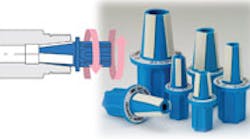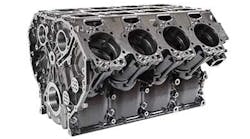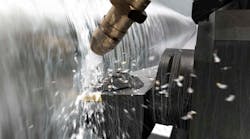Gerard Vacio, Workholding Product Manager at BIG Kaiser Precision Tooling, has some good advice for managing toolholder assemblies: The relationship of the tool to the toolholder is just as important as the relationship of the toolholder to the spindle. Unlike spindles, which operate within the controlled environment of the machine, toolholders can be exposed to many pollutants around the shop. During storage and between uses, toolholders run a high risk of picking up oils, dust and other particles that can contaminate their surfaces. Cleaning the exteriors of toolholders is an important step before placing them into a tool changer or spindle.
Before loading a cutting tool into a machine, several factors may need to be qualified. The process of assembling a tool can introduce variables such as runout, balance, size and rigidity.
The best way to control these variables? Be sure to have clean components that are geometrically correct. A toolholder is designed to hold the tool with sufficient clamping force to overcome the forces of the cutting operation. It also must deliver the tool to the spindle centerline. Both of these functions can be degraded by contamination. Reductions in gripping strength and deviations from centerline will lower tool performance, so cleanliness is critical to achieving maximum tool life and material removal rates.
All toolholders have a better chance of delivering the tool to the proper location and holding them firmly when components are clean and free of contamination. Complex toolholders, such as collet chucks, should be completely disassembled and cleaned between uses. Wipers are available to clean the internal surfaces of the collet body and the spring collet should have contamination removed with cleaning systems such as ultrasonic or high-pressure washers. Once all components have been cleaned, toolholder assembly can begin. The toolholder should be protected while it is being assembled and disassembled to keep from damaging surfaces.
Tool assembly devices are available to assist in safely gripping toolholders. Avoid serrated grippers or loose fits that can easily scar tools and toolholder shanks. When tools and holders are required to rotate at high speeds, it is critical that their original surfaces are preserved.
When spindle speeds require a balanced tool, there are two approaches to delivering a qualified tool to the spindle. The first uses precision, balanced components. If everything is clean and in proper operating condition, components can be assembled and sent directly to the machine tool. If the toolholder components and cutting tool are manufactured to a lower level of precision, they can be assembled, balanced offline, and be transferred to the machine tool.
Offline tool presetters are excellent devices for finding and removing run-out from tool assemblies outside of the machine spindle. They also are the best way to set tools to specific sizes. As a measuring and inspection device, tool presetters can inspect and measure all forms of geometry associated with today’s most complex cutting tools. In lieu of offline presetting, probing systems can be installed in the machines to measure and monitor tool lengths.







